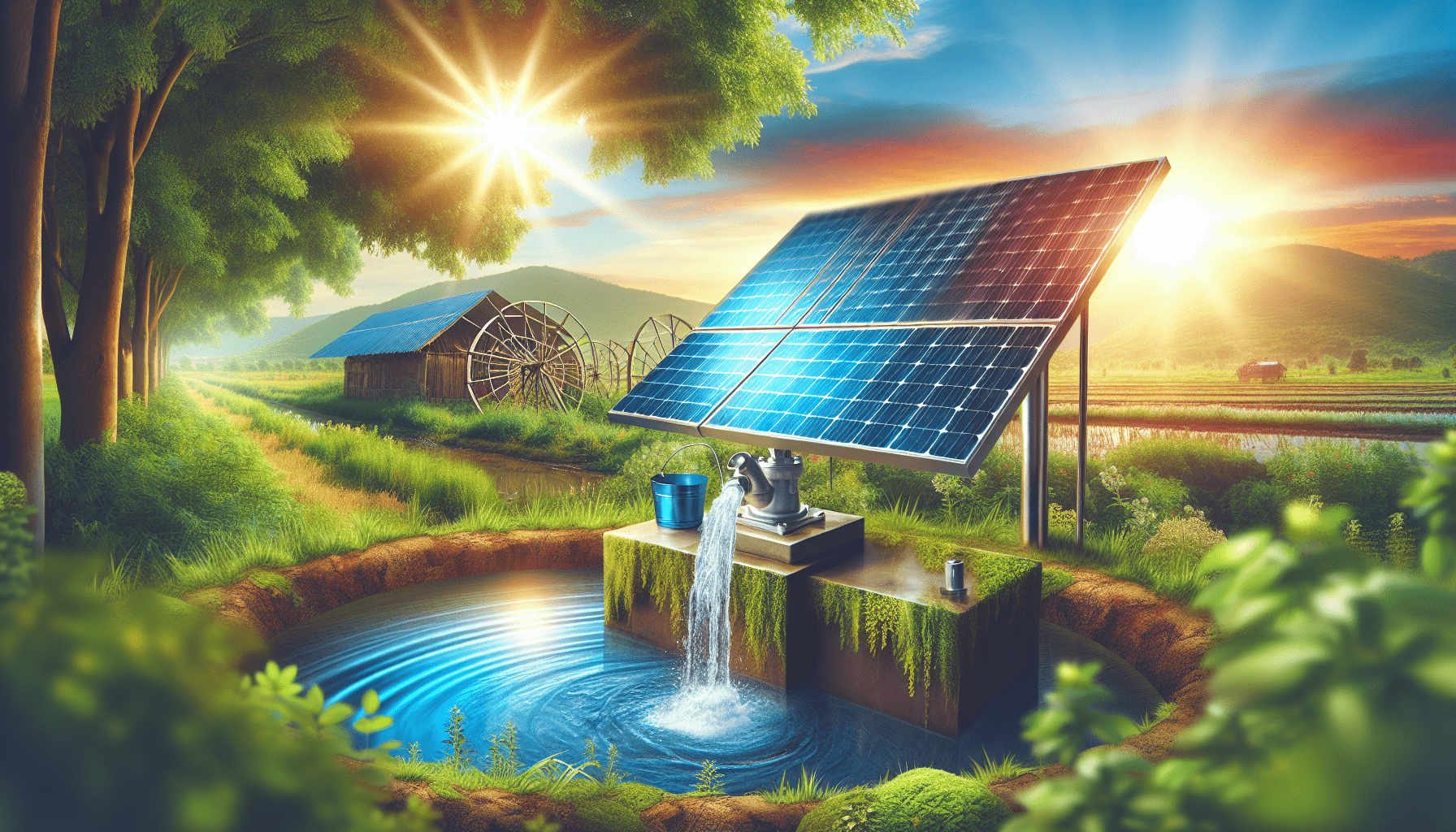Harnessing Solar Power for Efficient Water Pumping Solutions
As an Amazon Associate, I earn from qualifying purchases, at no additional cost to you. Disclaimer
Have you ever wondered how we can use the abundant energy of the sun for something as essential as pumping water? The idea of pairing solar power with water pumping might sound like a concept from the future, but it’s a readily available solution today. Harnessing solar power for water pumping offers an innovative, sustainable approach that holds immense promise for both agricultural and household use. Let’s explore this fascinating intersection of technology and nature to understand the benefits and workings of solar-powered water pumps.
Click Here to Go Solar and Save
Introduction to Solar Power: A Sustainable Choice
Solar power is a remarkable source of renewable energy. It involves capturing the sun’s energy and converting it into electricity. This is not only environmentally friendly but also a cost-effective choice in the long run. Using solar power ensures reduced dependence on conventional fossil fuels, leading to lower carbon emissions and a smaller ecological footprint.
The Basics of Solar Energy
The sun emits energy in the form of light and heat, which can be harnessed using various technologies. Photovoltaic (PV) cells are the most common tool used to capture sunlight and convert it into electricity. By using these cells, solar panels are able to generate electrical power that can be used for a variety of applications, including water pumping.
Why Opt for Solar Energy?
Opting for solar energy means tapping into an inexhaustible source that is both clean and reliable. It offers a level of energy independence, especially crucial for remote areas where access to traditional energy sources may be limited. Solar technology has rapidly advanced, making it more affordable and accessible than ever before.
Understanding Solar-Powered Water Pumps
Solar-powered water pumps use photovoltaic technology to draw power directly from sunlight, which then operates the pump to move or elevate water. This process is especially beneficial in regions with ample sunlight and where electricity or fuel are scarce or expensive.
How Do Solar-Powered Water Pumps Work?
At its core, a solar-powered water pumping system consists of solar panels, a controller, a pump, and sometimes a storage tank. The solar panels absorb sunlight and convert it into electricity, which the controller uses to operate the pump. Depending on the specific system, the pump may either directly distribute water or store it in a tank for later use.
Types of Solar Water Pumps
There are primarily two types of solar water pumps: surface pumps and submersible pumps.
Surface Pumps: These are installed above ground and are ideal for pumping water from shallow sources, like streams or ponds.
Submersible Pumps: These are installed underwater and are suitable for deeper water sources, such as wells or deep groundwater reserves.
You can select the suitable pump type depending on the depth of your water source and the volume of water you need to move or cooperate.
Advantages of Solar Water Pumps
The benefits of using solar-powered water pumps are numerous. They reduce operating costs because they rely on free solar energy instead of expensive fuels. They are also environmentally friendly, contributing to the reduction of greenhouse gases. Moreover, solar pumps are generally low-maintenance, with fewer moving parts and no dependency on external power sources.

Click Here to Power Your Home with Solar
Applications in Agriculture
In agriculture, water is a critical resource. Solar-powered water pumps can significantly enhance the efficiency of water usage for farming operations, making them particularly advantageous for irrigation in areas where traditional power sources are hard to access.
Irrigation Made Efficient
These pumps are well-suited for drip, sprinkler, and flood irrigation, allowing for efficient water management and improved crop yields. They provide a sustainable solution for farmers to maintain productivity even in water-scarce conditions.
Storage Solutions for Consistent Supply
Storage tanks can be paired with these systems to ensure a consistent water supply. When sunlight is abundant, excess water can be pumped into tanks for use during cloudy days or at night, ensuring that crops receive a constant water supply.
Case Study: A Sustainable Farm Model
Consider a small farm in a sunny region, previously burdened by the high cost of diesel-powered pumps. By switching to solar pumps, the farm not only reduces operational costs but also stabilizes its water supply, leading to more consistent and higher-quality yields.
Residential and Community Uses
Beyond agriculture, solar pumps hold immense potential for residential and community water supply systems. They provide a reliable and cost-effective means of accessing water in rural and off-grid areas.
Household Water Supply
For individual households, solar water pumps can be used for daily domestic needs such as drinking water, cooking, and cleaning. These systems can be a game-changer for remote homes, improving quality of life without enduring high energy costs.
Community Water Access
In remote communities, a central solar water pumping system can distribute water to multiple homes, schools, and healthcare facilities. This promotes better hygiene and health outcomes, while fostering a simplified and communal approach to water resource management.
Economic and Social Benefits
The initial investment in solar water systems can be offset by long-term savings and social prosperity. By eliminating the daily chore of fetching water—a task often undertaken by women and children in developing regions—solar pumps can enable these community members to pursue education or other income-generating endeavors.

Click Here to Discover Solar-Powered Solutions
Implementing Solar Pump Systems
Transitioning to solar-powered water pumps entail considering multiple variables, from pump sizing to the local environmental conditions. Proper planning ensures that the system meets specific water demand requirements.
Assessing Energy Needs
Calculate the daily water requirements and determine the potential solar energy available in your location. This includes evaluating how much sunlight you receive annually, which influences the system’s efficiency and reliability.
Sizing Panels and Pumps
Selecting the right size for both panels and pumps is crucial. An undersized panel won’t generate sufficient power, while an oversized system results in unnecessary cost. Professional assessment will typically involve detailing water quantity needs, the total dynamic head (total lift of the water, which includes height and friction losses), and the solar insolation levels.
Considerations for Installation
A competent installation considers panel placement for optimal sunlight exposure, local weather patterns, and long-term maintenance strategies. Ensuring that all technical components are compatible and correctly installed is key to operational longevity.
Overcoming Challenges
As with any technology, solar-powered water systems face challenges that can be mitigated with adequate planning and resources.
Upfront Costs and Financing
Initial setup costs can be a barrier, but numerous financing opportunities exist. Governments and environmental organizations often provide subsidies or low-interest loans for renewable energy projects.
Ensuring Performance and Longevity
Regular maintenance and periodic inspections help maintain peak performance. Keeping the panels clean from dust and obstructions, ensuring secure connections, and replacing parts when necessary are part of maintaining an efficient system.
Conclusion: A Bright Future with Solar Power
Solar-powered water pumps provide an insightful blend of energy efficiency, environmental stewardship, and practical utility. As innovation continues to drive down costs and increase system efficiency, the adoption of solar water pumping solutions is set to expand further. By tapping into solar energy, communities worldwide can access a reliable, sustainable water source that empowers agricultural productivity, enhances quality of life, and contributes to a healthier planet. As awareness and adoption grow, solar-powered pumps will indeed light the path to a brighter and more sustainable future.
So, the next time you think about renewable energy solutions, consider how solar power might not just illuminate our homes but also keep our water flowing efficiently and sustainably.

